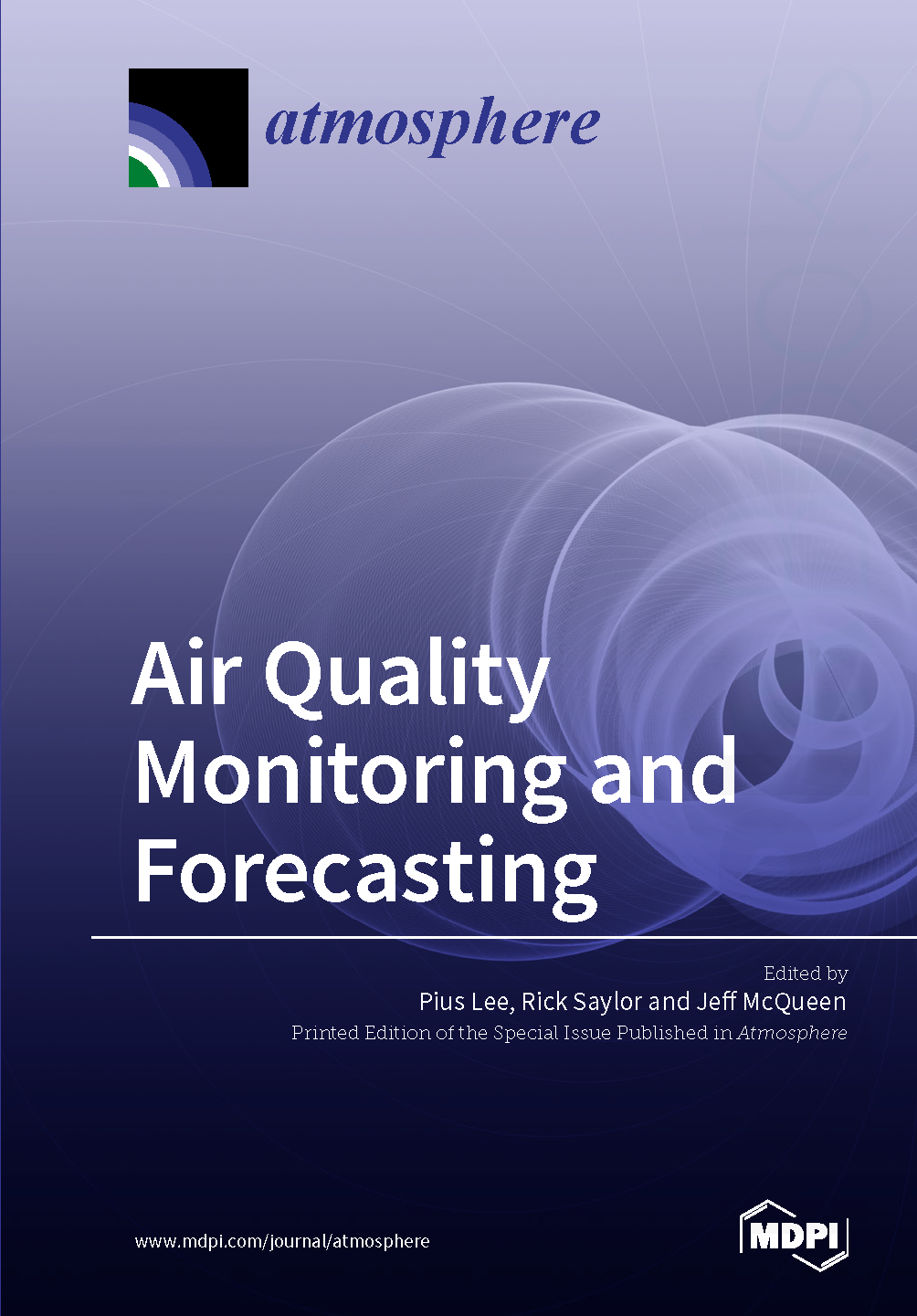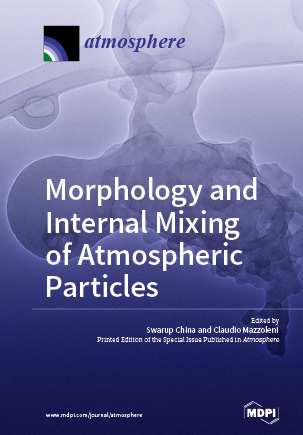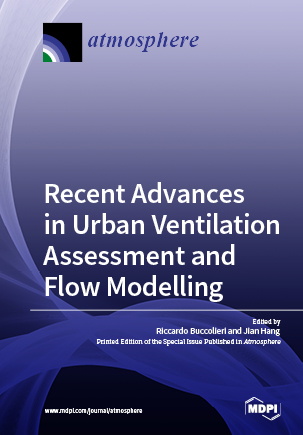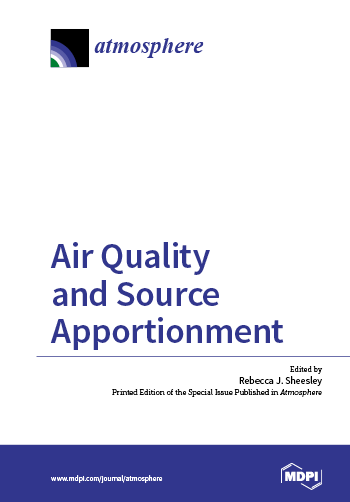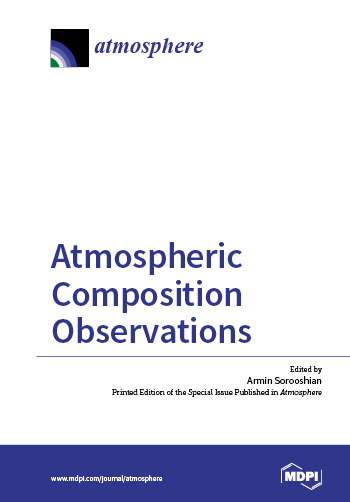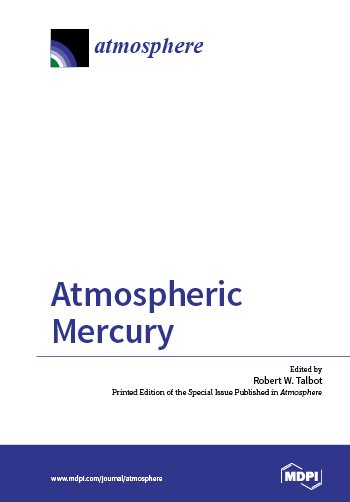
The 3rd International Electronic Conference on Atmospheric Sciences
Part of the International Electronic Conference on Atmospheric Sciences series
16–30 November 2020
Biometeorology, Aerosols, Air Quality and Human Health, Climate Dynamics and Modeling, Climatology and Meteorology, Atmospheric Physics, Atmospheric Chemistry
- Go to the Sessions
- Event Details
ECAS 2020 has been a success! Welcome to the new electronic conference EACS 2023.
Welcome from the Chair
Dear Colleagues,
You are cordially invited to participate in the 3rd International Electronic Conference on Atmospheric Sciences. With this meeting, we hope to build on the first two versions of the conference. We concede that sharing our work face-to-face with our colleagues is preferred, however, the COVID-19 crisis forced many conferences to postpone or cancel their meetings. Technology is continuously improving the virtual experience and we hope to take advantage of the latest developments in order to create a quality online meeting.
For the third electronic conference in atmospheric sciences, the range of topics will remain more general, but we would be open to future meetings or subject areas having a thematic topic of importance. During the last few decades, great strides have been made in all general areas of atmospheric science. We have seen the proliferation of remote sensing technologies and techniques for their use in research and forecasting. We have seen advances in the understanding of synoptic and dynamic meteorology which have improved weather forecasting. Advances in the capabilities of atmospheric modelling as well as increases in computing power have enhanced our understanding of atmospheric behaviors on all time and space scales. Additionally, there have been discoveries related to the behavior of smaller-scale systems, especially those that interact with human activity, health, and economics. These have inspired techniques for warning people that these events could affect them. The increased understanding of interannual and interdecadal variability in climate has also led to the development of long-range forecasting and projection. In conclusion, this conference will be organized around the following general and related themes which correspond to the Atmosphere journal.
- Aerosols
- Air Quality
- Air Quality and Human Health
- Climatology
- Meteorology
- Biometeorology
- Atmospheric Techniques, Instrumentation, and Modelling
- Biosphere / Hydrosphere / Land-Atmosphere Interactions
- Upper Atmosphere
- Planetary Atmospheres.
Accepted papers will be published in the proceedings of the conference in MDPI’s online journal, Atmosphere Special Issue "Selected Papers from the Third International Electronic Conference on Atmospheric Sciences" after peer review and enjoy 20% discount on processing fees.
Prof. Dr. Anthony R. Lupo
Chairman of ECAS 2020
 |
Dr. Anthony R. Lupo, is a Professor of Atmospheric Sciences in the Soil, Environmental, and Atmospheric Sciences Department at the University of Missouri. He earned his BS in Meteorology from the State University of New York at Oswego in 1988, and his M.S. and Ph.D. degrees from Purdue University in 1991 and 1995, respectively. His research has been in the areas of large-scale atmospheric dynamics, climate dynamics, and climate change including modeling, and he has more than 130 peer-reviewed publications between each of these areas. Additionally, he edited and contributed to the book Recent Hurricane Research: Climate, Dynamics, and Societal Impacts (published in 2011), and in 2014, 2015, and 2018 he was the Lead Guest Editor of the publication Advances in Meteorology Special Issue: Large-Scale Dynamics, Anomalous Flows, and Teleconnections. He has been a member of the American Meteorological Society since 1987 (Certified Consulting Meteorologist #660), and the National Weather Association since 1998. As a CCM, he served on the governing board from 2014-2017, serving as Board Chair during 2017. He was a Fulbright Scholar during the summer of 2004 to Russia, studying climate change at the Russian Academy of Sciences in Moscow. He won Fulbright scholarships to teach and research at Belgorod State National Research University in Russia for 2014–2015, and fall 2017. Additionally, he has served as an expert reviewer and/or contributing author to the Intergovernmental Panel on Climate Change (IPCC) (sponsored by the United Nations, World Meteorological Organization). His other professional associations include the Royal Meteorological Society (Fellow), American Geophysical Union, Sigma Xi, Gamma Sigma Delta, Phi Kappa Phi, and the Missouri Academy of Science (Fellow). He has won awards for teaching and advising at the University of Missouri, including the College of Agriculture, Food, and Natural Resources Senior Teaching Award (2006), the Outstanding Undergraduate Advisor Award (April 2008), and the University of Missouri Kemper Foundation Award for Excellence in Teaching (April 2008). He was awarded the Most Distinguished Scientific Achievement Award by the Missouri Academy of Science (2009), and University of Missouri professor of the year (May, 2010). In October 2013 he was awarded the Outstanding Alum for the year 2013 by the Earth and Atmospheric Science Department at Purdue. He is listed on the Fulbright Specialist Roster (2016-2022), and was part of the scientific committee for the First Conference on Atmospheric Blocking in Reading England (2014-2016). |
Conference Secretariat
Ms. Xue Liang
MDPI Branch Office, Wuhan
E-Mail: ecas2020@mdpi.com
Ms. Macie Ma
MDPI Branch Office, Wuhan
E-Mail: ecas2020@mdpi.com
Mr. Aaron Shen
MDPI Branch Office, Wuhan
E-Mail: ecas2020@mdpi.com
Call for papers
The 3rd International Electronic Conference on Atmospheric Sciences (ECAS 2020) will be held from 16 to 30 November online. This event enables the researchers of atmospheric science to present their research and exchange ideas with their colleagues without the need to travel. All proceedings will be published on the conference homepage in open access format.
Through this event, we aim to cover the following topics:
- Aerosols (Section S1)
- Air Quality (Section S2)
- Air Quality and Human Health (Section S3)
- Climatology (Section S4)
- Meteorology (Section S5)
- Biometeorology (Section S6)
- Atmospheric Techniques, Instruments, and Modeling (Section S7)
- Biosphere/Hydrosphere/Land–Atmosphere Interactions (Section S8)
- Upper Atmosphere (Section S9)
- Planetary Atmospheres (Section S10)
The conference will be completely free of charge—both to attend and for scholars to upload and present their latest work on the conference platform. There will also be the possibility to submit selected papers to the journal Atmosphere (ISSN 2073-4433; Impact Factor: 2.046 (JCR 2018); 5-Year Impact Factor: 2.253 (JCR 2018)) with a 10% discount on the APCs; ECAS 2020 offers you the opportunity to participate in this international, scholarly conference without having the concern or expenditure of travel — all you need is your computer and access to the Internet. We would like to invite you to “attend” this conference and present your latest work.
Abstracts (in English) should be submitted by 24 August 2020 online at https://www.sciforum.net/login. For accepted abstracts, the full paper can be submitted by 5 October 2020. The conference itself will be held 16–30 November 2020.
We hope you will be able to join this exciting event and support us in making it a success. ECAS 2020 is organized and sponsored by MDPI, a scholarly open access publisher based in Basel, Switzerland.
Paper Submission Guidelines
For information about the submission procedure and preparation of a full presentation, please refer to the "Instructions for Authors".
Critical Dates
Conference Chairs

Department of Soil, Environmental, and Atmospheric Science, University of Missouri-Columbia, Columbia, MO 65211, USA
Dr. Anthony R. Lupo, is a Professor of Atmospheric Sciences in the Soil, Environmental, and Atmospheric Sciences Department at the University of Missouri. He earned his BS in Meteorology from the State University of New York at Oswego in 1988, and his M.S. and Ph.D. degrees from Purdue University in 1991 and 1995, respectively. His research has been in the areas of large-scale atmospheric dynamics, climate dynamics, and climate change including modeling, and he has more than 130 peer-reviewed publications between each of these areas. Additionally, he edited and contributed to the book Recent Hurricane Research: Climate, Dynamics, and Societal Impacts (published in 2011), and in 2014, 2015, and 2018 he was the Lead Guest Editor of the publication Advances in Meteorology Special Issue: Large-Scale Dynamics, Anomalous Flows, and Teleconnections. He has been a member of the American Meteorological Society since 1987 (Certified Consulting Meteorologist #660), and the National Weather Association since 1998. As a CCM, he served on the governing board from 2014-2017, serving as Board Chair during 2017. He was a Fulbright Scholar during the summer of 2004 to Russia, studying climate change at the Russian Academy of Sciences in Moscow. He won Fulbright scholarships to teach and research at Belgorod State National Research University in Russia for 2014–2015, and fall 2017. Additionally, he has served as an expert reviewer and/or contributing author to the Intergovernmental Panel on Climate Change (IPCC) (sponsored by the United Nations, World Meteorological Organization). His other professional associations include the Royal Meteorological Society (Fellow), American Geophysical Union, Sigma Xi, Gamma Sigma Delta, Phi Kappa Phi, and the Missouri Academy of Science (Fellow). He has won awards for teaching and advising at the University of Missouri, including the College of Agriculture, Food, and Natural Resources Senior Teaching Award (2006), the Outstanding Undergraduate Advisor Award (April 2008), and the University of Missouri Kemper Foundation Award for Excellence in
LupoA@missouri.edu
Conference Committee

School of Biological Sciences, University of Essex, Colchester CO4 3SQ, UK
Interests: physico-chemical properties of aerosols; indoor air quality and health impacts of aerosols; nanoparticles in the environment; environment–society interactions
colbi@essex.ac.uk

Department of Physical and Chemical Sciences, Università degli Studi dell’Aquila, 67010 Coppito, L’Aquila, Italy
Interests: regional tropospheric chemistry and air quality; global and regional modeling of atmospheric aerosols and their radiative effects; aerosol-cloud interactions; intercontinental transport of trace gases and aerosols; aerosol optical properties an
gabriele.curci@aquila.infn.it

Research Center Human Biometeorology, Deutscher Wetterdienst, Stefan-Meier-Str. 4, 79104 Freiburg, Germany
Interests: human-biometeorology; urban bioclimatology; climate and tourism; climate impact research
andreas.matzarakis@dwd.de

Atmospheric Science Program, Department of Physics & Astronomy, University of Louisville, Louisville, KY 40292, USA
Interests: planetary atmospheric dynamics; jet streams; vortices; shear instability; comparative planetology
timothy.dowling@louisville.edu

Department of Chemistry, Biology and Biotechnology, Università Degli Studi di Perugia, Via Elce Di Sotto 8, 06123 Perugia, Italy
Interests: elementary processes in the gas phase; molecular clusters; chemical and physical characterization of atmospheric aerosols; remote environments; vertical profiles of aerosol properties; aerosol source apportionment; chemical transport models
david.cappelletti@unipg.it

Laboratory of Meteorology, Department of Physics, University of Ioannina, 45110 Ioannina, Greece
Interests: aerosol physical properties; aerosol-cloud interactions; aerosol-radiation interactions; radiation and climate; shortwave and longwave radiation transfer and budgets
nhatzian@uoi.gr

Department of Civil & Environmental Engineering, The University of Toledo, Toledo, OH 43606, USA
Interests: air quality modeling; indoor radon; risk analysis; biodiesel; data analysis
ashok.kumar@utoledo.edu

Institute for Coastal Research, Helmholtz-Zentrum Geesthacht - Zentrum für Material- und Küstenforschung, 21502 Geesthacht, Germany
Interests: climate; climate change; climate statistics; detection and attribtion; adaptation; coastal seas and regions; marine risks; climate policy; climate communication; climate knowledge
hvonstorch@web.de

Consortium for Capacity Building (CCB/INSTAAR), University of Colorado, Boulder 80309, USA
Interests: DRR; CCA; climate; weather and water; El Niño; La Niña; sustainability; ENSO; disaster; risk; reduction; changing climate; China OBOR
mickeyglantz@hotmail.com

Dipartimento di Scienze e Tecnologie Biologiche ed Ambientali (DiSTeBA), University of Salento, S.P. 6 Lecce-Monteroni, 73100 Lecce, Italy
Interests: urban air quality and microclimate; experimental and computational fluid dynamics; turbulence and pollutant dispersion; city breathability and urban vegetation
riccardo.buccolieri@unisalento.it

Department of Marine, Earth, and Atmospheric Sciences, North Carolina State University, Raleigh, NC 27695, USA
Interests: environment; air quality; and climate; emission; transport; transformation; fate of pollutants; agricultural air quality; climate change; biogeochemical cycling of pollutants; measurement and modeling of biogenic emissions of trace gases; photo
vpaneja@ncsu.edu

Centre for Atmospheric and Climate Physics Research (CACP), University of Hertfordshire, Hatfield, Hertfordshire, AL10 9AB, UK
Interests: air quality and meteorological modelling; atmospheric composition; climate interactions; source apportionment and integrated observations
r.s.sokhi@herts.ac.uk

Urban Environment and Industry Department, NILU – Norwegian Institution for Air Research, 2027 Kjeller, Norway
Interests: urban sustainability; air quality; sensor technology; novel monitoring technologies; air quality modeling; citizen science and citizen involvement; governance; education; art and science interaction
ncb@nilu.no

Faculty of Power and Environmental Engineering, Department of Technologies and Installations for Waste Management, Silesian University of Technology, 18 Konarskiego St., 44-100 Gliwice, Poland
Interests: air pollution; indoor air quality; air sampling; aerobiology; environmental microbiology; bioaerosols; bacteria; fungi
Ewa.Bragoszewska@polsl.pl
Section of Environmental Physics and Meteorology, Department of Physics, National and Kapodistrian University of Athens, University Campus, 157 84 Athens, Greece
Interests: climate dynamics; climate physics; climate change and variability; aerosols; ambient air quality; ozone-climate interactions; atmospheric physics and chemistry; nonlinear processes; artificial intelligence and machine learning; remote sensing
chtzanis@phys.uoa.gr

Instituto Superior Técnico, Centro de Química Estrutural, Chemical Engineering Department, University of Lisbon,1049-001 Lisboa, Portugal
Interests: environmental chemistry; mercury biogeochemical cycle in aquatic environments; mercury toxicology; environmental pollution; marine biogeochemistry; mercury in polar environments
rute.cesario@tecnico.ulisboa.pt

Institute of Atmospheric pollution Research (IIA), C.N.R., - 00015 Monterotondo (Roma), Italy
Interests: air pollution; airborne particulate matter; electron microscopy; source apportionment
pietrodangelo@iia.cnr.it

Faculty of Engineering, Department of Civil and Environmental Engineering, Imperial College London, London SW7 2AZ, UK
Interests: ecohydrological modelling; uncertainty quantification; physically-based modelling; earth system modelling
a.paschalis@imperial.ac.uk
Keynote Speakers

Department of Soil, Environmental, and Atmospheric Science, University of Missouri-Columbia, Columbia, MO 65211, USA
blocking anticyclones
Interests: dynamic meteorology; synoptic meteorology; climate dynamics; climate variability
LupoA@missouri.edu

Department of Marine, Earth, and Atmospheric Sciences, North Carolina State University, Raleigh, NC 27695, USA
Interests: environment; air quality; and climate; emission; transport; transformation; fate of pollutants; agricultural air quality; climate change; biogeochemical cycling of pollutants; measurement and modeling of biogenic emissions of trace gases; photo
vpaneja@ncsu.edu

Centre for Atmospheric and Climate Physics Research (CACP), University of Hertfordshire, Hatfield, Hertfordshire, AL10 9AB, UK
Interests: air quality and meteorological modelling; atmospheric composition; climate interactions; source apportionment and integrated observations
r.s.sokhi@herts.ac.uk

Department of Chemistry and Biochemistry, Utah State University, Vernal, UT 84078, USA
Interests: wintertime ozone; energy source emissions characterization, and atmospheric instrument innovation and development
seth.lyman@usu.edu

Department of Chemistry, University of Kentucky, Lexington, KY 40506, USA
Interests: environmental photochemistry; interfacial oxidations; environmental monitoring; prebiotic chemistry; photocatalytic CO2 reduction; environmental chemistry
marcelo.guzman@uky.edu
Instructions for Authors
Submissions should be done by the authors online by registering with www.sciforum.net, and using the "New Submission" function once logged into system.
- Scholars interested in participating with the conference can submit their abstract (about 150-300 words covering the areas of manuscripts for the proceedings issue) online on this website until 24 August 2020.
- The Conference Committee will pre-evaluate, based on the submitted abstract, whether a contribution from the authors of the abstract will be welcome for the ECAS 2020. All authors will be notified by 7 September 2020 about the acceptance of their abstract.
- If the abstract is accepted for this conference, the author is asked to submit his/her manuscript, optionally along with a PowerPoint (only PDF) and/or video presentation of his/her paper, until the submission deadline of 5 October 2020.
- The manuscripts and presentations will be available on ECAS 2020 homepage for discussion and rating during the time of the conference 16-30 November 2020.
- Accepted papers will be published in the proceedings of the conference and journal Atmosphere will publish the proceedings of the conference as a Special Issue. After the conference, the authors are recommended to submit an extended version of the proceeding papers to the Atmosphere Special issue with 20% discount on the APC.
Manuscripts for the proceedings issue must have the following organization:
- Title
- Full author names
- Affiliations (including full postal address) and authors' e-mail addresses
- Abstract
- Keywords
- Introduction
- Methods
- Results and Discussion
- Conclusions
- (Acknowledgements)
- References
Manuscripts should be prepared in MS Word and should be converted to the PDF format before submission. The publication format will be PDF. There is no page limit on the length, although authors are asked to keep their papers as concise as possible.
Microsoft Word
Authors must use the Microsoft Word template to prepare their manuscript. Using the template file will substantially shorten the time to complete copy-editing and publication of accepted manuscripts. Manuscript prepared in MS Word must be converted into a single file before submission. Please do not insert any graphics (schemes, figures, etc.) into a movable frame which can superimpose the text and make the layout very difficult.
- Paper Format: A4 paper format, the printing area is 17.5 cm x 26.2 cm. The margins should be 1.75 cm on each side of the paper (top, bottom, left, and right sides).
- Formatting / Style: Papers should be prepared following the style of ECAS 2017 template. The full titles and the cited papers must be given. Reference numbers should be placed in square brackets [ ], and placed before the punctuation; for example [4] or [1-3], and all the references should be listed separately and as the last section at the end of the manuscript.
- Authors List and Affiliation Format: Authors' full first and last names must be given. Abbreviated middle name can be added. For papers written by various contributors a corresponding author must be designated. The PubMed/MEDLINE format is used for affiliations: complete street address information including city, zip code, state/province, country, and email address should be added. All authors who contributed significantly to the manuscript (including writing a section) should be listed on the first page of the manuscript, below the title of the article. Other parties, who provided only minor contributions, should be listed under Acknowledgments only. A minor contribution might be a discussion with the author, reading through the draft of the manuscript, or performing English corrections.
- Figures, Schemes and Tables: Authors are encouraged to prepare figures and schemes in color. Full color graphics will be published free of charge. Figure and schemes must be numbered (Figure 1, Scheme I, Figure 2, Scheme II, etc.) and a explanatory title must be added. Tables should be inserted into the main text, and numbers and titles for all tables supplied. All table columns should have an explanatory heading. Please supply legends for all figures, schemes and tables. The legends should be prepared as a separate paragraph of the main text and placed in the main text before a table, a figure or a scheme.
For further inquiries please contact the Conference Secretariat.
Authors are also encouraged to submit video presentations. The video will be uploaded to Youtube, as well as onto Sciforum. The video should be no longer than 20 minutes and be prepared with the following formats,
- .MOV
- .MPEG4
- .MP4
- .AVI
- .WMV
- .MPEGPS
- .FLV
The video should be submitted via email before 24 August 2020.
Posters will be available on this conference website during and after the event. Like papers presented on the conference, participants will be able to ask questions and make comments about the posters. Posters that are submitted without paper will not be included in the proceedings of the conference.
It is the authors' responsibility to identify and declare any personal circumstances or interests that may be perceived as inappropriately influencing the representation or interpretation of clinical research. If there is no conflict, please state here "The authors declare no conflict of interest." This should be conveyed in a separate "Conflict of Interest" statement preceding the "Acknowledgments" and "References" sections at the end of the manuscript. Financial support for the study must be fully disclosed under "Acknowledgments" section. It is the authors' responsibility to identify and declare any personal circumstances or interests that may be perceived as inappropriately influencing the representation or interpretation of clinical research. If there is no conflict, please state here "The authors declare no conflict of interest." This should be conveyed in a separate "Conflict of Interest" statement preceding the "Acknowledgments" and "References" sections at the end of the manuscript. Financial support for the study must be fully disclosed under "Acknowledgments" section.
MDPI AG, the publisher of the Sciforum.net platform, is an open access publisher. We believe that authors should retain the copyright to their scholarly works. Hence, by submitting a Communication paper to this conference, you retain the copyright of your paper, but you grant MDPI AG the non-exclusive right to publish this paper online on the Sciforum.net platform. This means you can easily submit your paper to any scientific journal at a later stage and transfer the copyright to its publisher (if required by that publisher).
List of accepted submissions (51)
| Id | Title | Authors | Presentation Video | Poster PDF | |||||||||||||||||||||||||||||||||||||
|---|---|---|---|---|---|---|---|---|---|---|---|---|---|---|---|---|---|---|---|---|---|---|---|---|---|---|---|---|---|---|---|---|---|---|---|---|---|---|---|---|---|
| sciforum-032345 | Experimental Tests of Peculiarity of Ice Nucleation on Different Materials | N/A | N/A |
Show Abstract |
|||||||||||||||||||||||||||||||||||||
|
The analogy of heterogenic ice nucleation in bulk immersion freezing of the atmospheric droplets with aerosol particle in it and freezing of moisture within the wet grounds was considered. For the experiment there were taken modeled sandy and kaolinite grounds with the weight wetness of about 25% and 90% and with the total mass of about 100 g and 80 g respectively. The samples were placed in the stainless steel or plastic dishes and were cooled down in the refrigerated chamber with ambient temperature of about -5°C. The ground samples’ temperatures were measured and recorded. The temperatures of the moment of ice nucleation in the grounds were determined. The performed experiments of the ground samples freezing indicated that ice nucleation in the considered experimental samples of sandy and kaolinite grounds happen at the temperatures of about -4°C (close to the ambient temperature of refrigerated chamber (-5°C)). This may be compared to the results of the heterogenic ice nucleation on the particles of sand and kaolinite immersed in the water droplet presented in the works (Marcolli et al., 2007, Pinti et al., 2012, Kaufmann et al., 2016). |
|||||||||||||||||||||||||||||||||||||||||
| sciforum-032494 | Effect on the Air Quality and Noise Levels of Jaipur City in the Event of COVID-19: A Short Review | N/A | N/A |
Show Abstract |
|||||||||||||||||||||||||||||||||||||
|
Jaipur has seen a rapid development in the last two and a half decades being the capital city of Rajasthan and its proximity to the National capital region of India, directly impacting its environment. This systematic review and meta-analysis aimed to evaluate the status of air pollution based on available literature. A review based on status of air pollution beginning with works of researchers in 1996-97 period for Jaipur city, till the recent developments through published literature is presented here in the light of abrupt and extreme situations arising due to COVID-19. High Volume Samplers having respirable dust sampler with dust collector and filter paper were utilized in these studies and it was conducted by dividing the city into various categories such as: industrial area, commercial area, residential area, and sensitive area. Sulphur dioxide and nitrogen dioxide were measured by doing gas sampling and passing the gas through absorbing solution of sodium tetrachloromercurate and sodium hydroxide – sodium arsenite solution respectively. Carbon monoxide monitors of type CO-200 were being used to detect presence of CO and indicate the concentration in ppm. Researchers have found that the recorded mean values of PM2.5 and PM10 were much higher than the specified limit by National Ambient Air Quality Standards (NAAQS). Sound level meters were used for the measurement of noise levels. Currently, daily AQI results are provided through online services based on PM2.5, PM10, NO2, NH3, SO2, CO and ozone. The AQI on 15th May 2020 is 92, 98, and 100 at 9:00 AM, 11:00 AM, and 2:00 PM representing satisfactory category. However, AQI was 102 (moderate) at 3:00 PM and 4:00 PM. Jaipur is witnessing a major improvement in the air quality index (AQI) and noise levels during the COVID-19 crisis period due to limited anthropogenic activity since mid-March 2020. |
|||||||||||||||||||||||||||||||||||||||||
| sciforum-032612 | Estimation of Direct Fire Emissions from Forests Burning in Siberia | N/A | N/A |
Show Abstract |
|||||||||||||||||||||||||||||||||||||
|
Using a database on wildfires recorded by remote sensing for 1996–2020, we assessed the seasonal variation of direct carbon emissions from the burning in Siberian forests. We have implemented an approach that takes into account the combustion parameters and the changing intensity of the fire (in terms of Fire Radiative Power, FRP), which affects the accuracy of the emission estimate. For the last two decades, the range of direct carbon emissions from wildfires was 20–250 Тg С per year. Sporadic maxima were fixed in 2003 (> 150 Тg С/yr), in 2012 (> 220 Тg С/yr), and in 2019 (> 190 Тg С/yr). Preliminary estimation of emissions for 2020 (on 30th of September) was ~180 Tg/year. Fires in the larch forests of the flat-mountainous taiga region (Central Siberia) made the greatest contribution (>50%) to the budget of direct fire emission, affecting the quality of the atmosphere in vast territories during summer period. According to the temperature rising and forest burning trend in Siberia, the fire emissions of carbon may double (220 Тg С/yr) or even increase by an order of magnitude (>2000 Тg С/yr) at the end of the 21st century, which was evaluated depending on IPCC scenario. |
|||||||||||||||||||||||||||||||||||||||||
| sciforum-032791 | Investigation of Precipitation Variability and Extremes Using Information Theory | , | N/A | N/A |
Show Abstract |
||||||||||||||||||||||||||||||||||||
|
Quantifying the spatiotemporal variability of rainfall is the principal component for the assessment of the impact of climate change on the hydrological cycle. A better understanding of the quantification of variability and its trend is vital for water resources planning and management. Therefore, a multitude of studies has been dedicated to quantifying the rainfall variability over the years. Despite their importance for modelling rainfall variability, the studies mainly focused on the amount of rainfall and its spatial patterns. The studies investigating the spatial and temporal variability of rainfall across Central India, in general, and at multiscale, in particular, are limited. In this study, we used a Standardized Variability Index (SVI), based on information theory to investigate the spatiotemporal variability of rainfall. The proposed measure is independent of the temporal scale, the length of the data and therefore, is able to compare the rainfall variability at multiple timescales. Distinct spatial patterns were observed for information entropies at the monthly and seasonal scale. Stations with statistically significant trends were observed and vary from monthly to seasonal scale. There is an increase in the variability of precipitation amount from South to North, indicating that spread of the rainfall is high in the South when compared to North of Central India. Trend analysis revealed there is changing behaviour in the rainfall amount as well as rainy days, showing an increase in variability of rainfall over Central India, hence the high probability of occurrence of extreme events in near future. |
|||||||||||||||||||||||||||||||||||||||||
| sciforum-032998 | Assessing Neural Network Approaches for Solar Radiation Estimates Using Limited Climatic Data in the Mediterranean Sea | , , | N/A | N/A |
Show Abstract |
||||||||||||||||||||||||||||||||||||
|
One of the most crucial variables in Agricultural Meteorology is Solar Radiation (Rs), although it is measured in a very limited number of weather stations due to its high cost in both installation and maintenance. Moreover, the quality of the data is usually low because of sensor failure and/or lack of calibration, which made scientists search for new approaches such as neural network models. Thus, the improvement of traditional solar radiation estimation models with minimum data availability is still needed for different purposes. In this work, several neural network models have been developed and assessed (Multilayer perceptron -MLP-, Support Vector Machines -SVM-, Extreme Learning Machine, Convolutional Neural Networks -CNN- and Long Short-Term Memory -LSTM-) with different temperature-based input variables configurations in Southern Spain (weather station located in the Mediterranean Sea coast). The performances have been analyzed using different statistical indices (Root Mean Square Error -RMSE-, Mean Bias Error -MBE-, correlation coefficient -R2- and Nash-Sutcliffe model efficiency coefficient -NSE-). |
|||||||||||||||||||||||||||||||||||||||||
Event Awards
Best Paper Award
This year, as a sponsor, Atmosphere would like to award the best paper as elected by the members of the scientific committee. The Award will consist of 500 Swiss Francs.
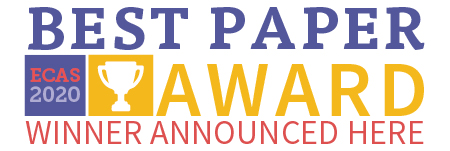
The Best Paper Award has been awarded to
- sciforum-035181, "Moisture Transport toward Europe and Extreme Precipitation Events"
Marta Vázquez *, Fátima da Silva Ferreira, Raquel Nieto, Margarida Liberato, Luis Gimeno
Terms and Conditions:
Criteria
1. Full paper must be submitted to ECAS2020.
2. The quality of the paper.
3. The scientific content of the paper
Evaluation
1. Each Evaluation Committee member will give an assessment for each paper in terms of the criteria outlined above.
2. The score for each paper will be ranked, from highest to lowest.
3. If two or more papers get the same score, further evaluation will be carried out.
4. All decisions made by the Evaluation Committee are final.
The Awards
Number of Awards Available: 1
The Award will consist of 500 Swiss Francs.Sponsors and Partners
For information regarding sponsorship and exhibition opportunities, please click here.
Media Partners
S1. Aerosols
Aerosol particles play a central role in the composition and radiation budget of the atmosphere. The aerosol distribution on global and regional scales is dependent on emission, chemical processing, removal and horizontal–vertical transport, and may significantly affect the local and regional air quality. A variety of measurement techniques and numerical modeling tools is used to study the aerosol spatial distribution and its effects on atmospheric composition and radiative transfer. The latter take place through a number of processes, from direct scattering and absorption of solar and planetary radiation to indirect effects related to the formation of cloud droplets and ice particles in the troposphere, or even in the stratospheric polar vortices. Other effects may play a substantial role in the atmospheric radiative transfer, for example, the aerosol deposition feedback on the albedo of snow/ice covered surfaces or the influence on atmospheric stability due to the absorption of radiation. A reliable estimate of the direct radiative effects can be reached if a good knowledge of the vertical distribution of the particles is reached, along with their size distribution and physical composition. A meaningful representation of the indirect effects needs to take several complex microphysical processes into account. Atmospheric aerosols may also cause a negative impact on human health and vegetation. Specific details on emission and chemical mechanisms concerning toxic particulate-borne species are required for an accurate assessment of exposure.
Keywords
- Anthropogenic and natural emissions;
- Primary and secondary atmospheric aerosols;
- Direct, semi-direct and indirect radiative effects;
- Aerosol–cloud interactions;
- Aerosol microphysics;
- Impact on air quality;
- Toxicity of aerosols;
- Large-scale transport;
- Chemical and physical properties;
- Measurements and modeling
Session Chair
Dr. Takemura Toshihiko, Research Institute for Applied Mechanics, Kyushu University, 6-1 Kasuga-koen, Kasuga, Fukuoka 816-8580, Japan https://sprintars.riam.kyushu-u.ac.jp/toshi/
S2. Air Quality
Air quality has become one of the greatest environmental issues of modern times, following improved access to fresh water in many parts of the world. Each year, both outdoor and indoor air pollution are thought to contribute to millions of premature deaths worldwide. Despite increased awareness of the hazards associated with air pollution, there remain significant gaps in our understanding of the science of air quality. Future research will lead to a better understanding of the sources of key atmospheric pollutants, including precursors and the chemistry that leads to production of atmospheric toxins. Improvements are needed in our understanding of the epidemiology of air quality and our understanding is also limited by a lack of comprehensive atmospheric composition measurements in the heterogeneous urban air-shed. Advances in air quality modelling techniques are also needed, as is an understanding of how to bridge the scales between atmospheric models and atmospheric observations. This section aims to publish research that contributes to a better understanding of all these aspects of air quality.
Keywords
- Sources of atmospheric pollutants;
- Hazardous and toxic substances;
- Air quality modelling;
- Air quality management;
- Sampling and analysis, measurement of air pollution;
- Atmospheric dispersion and transport;
- Air-surface (soil, water, and vegetation) exchange of pollutants;
- Indoor air quality;
- Air pollution meteorology;
- Air pollution climatology;
- Atmospheric impact assessment;
- Dry and wet deposition;
- Atmospheric chemistry;
- Greenhouse gases;
- Pollution control technologies;
- Energy and air pollution;
- Exposure assessment of air pollution.
S3. Air Quality and Human Health
The association between air quality and human health is one of the most controversial topics in current research. Air pollution is considered one of the leading environmental risk factor for human health globally, especially with regard to ambient fine particular matter (PM2.5), ozone, and some non-criteria pollutants that are considered to have the highest toxicity, such as metals, organics, ultrafine particles, and black carbon. The interplay between these variables and human health is a popular choice of study. Indirect health impacts also exist, for example, due to changes in vector-borne disease risk, food availability, and agricultural production. Both epidemiology and toxicity mechanism studies are needed to understand the role of air quality on specific health outcomes, including inflammation, DNA changes, cancer, respiratory and neurological diseases, severe cognitive deficit, and brain structural change. Notably, scientifically sound metrics to quantitatively measure atmosphere effects on human health, potentially causing several million deaths per year, are still missing. Therefore, it is necessary to develop significant scientific evidence to guide the development of new recommendations, policies, and legislation.
Articles that consider all associations between atmospheric composition and health impacts, especially with regard to air pollution and aerosols, aerobiology, toxicology, and epidemiology in all regions of the world, are welcome. We also welcome multidisciplinary studies that attempt to use the contextualization of science to solve this broad societal challenge.
Keywords
- air pollution;
- fine aerosol particles;
- ultrafine particles;
- epidemiology
- toxicology;
- exposure;
- doses;
- black carbon;
- metals;
- organics;
- metrics;
- legislation
S4. Climatology
Climate play a profound role on all human agricultural, economic, and recreational activities. The number of studies and topics involving Earth’s atmosphere and climate have proliferated since the early 20th century. This section will be devoted to topics that remain at the heart of climate inquest, including variability of the atmosphere, oceans, land surface, and cryosphere; past, present, and projected future changes in the climate system; and climate simulation and prediction, the impacts of global climate change, and climate change’s implications for the economy and policy.
Keywords
- Global and regional climate;
- Climate dynamics;
- Climate change and variability;
- Paleoclimate;
- Urban climate;
- Polarclimate;
- Tropical climate;
- Climate change and renewable energy;
- Climate policies, strategies, and management;
- Modelling.
S5. Meteorology
This section will be devoted to topics that remain at the heart of weather, including cross-disciplinary studies devoted to basic or applied research. The editorial board will review all manuscripts submitted for publication in this section. Articles deemed outside the scope of the subject matter listed here may be referred to another section of Atmosphere.
Keywords
- Precipitation, windspeed, and cloud formation;
- General circulation and teleconnections;
- Tropical meteorology;
- Boundary-layer meteorology;
- Mountain meteorology;
- Mesoscale meteorology;
- Physical meteorology;
- Operational meteorology;
- Synoptic and dynamic meteorology;
- Weather analysis and forecasting;
- Numerical methods.
Session Chair
Dr. Luis Gimeno, Department of Applied Physics, Environmental Physics Laboratory (EPhysLab), University of Vigo, 32004 Ourense, Spain
S6. Biometeorology
Biometeorology deals with the interactions between atmospheric conditions and living organisms (humans, vegetation and animals) in an interdisciplinary manner, as well as on how to inform, warn, respond to and mitigate adverse effects resulting from activities and climate change. The core questions are to assess how atmospheric conditions can impact on living organisms. The topic covers aspects from daily life to implications of global, regional and local climate change.
Examples are how the well-being and health of humans are related, how urban planning can improve atmospheric conditions (air quality, urban climate), atmospheric effects on agricultural and forest production and how to transfer such knowledge in a broadly understandable way in order to ensure the appropriate usage of such information. Atmospheric conditions include transient ones driven by weather patterns and long-term climatology, as well as how climate change trends may affect these drivers. In this context, the section wants to address issues concerning assessment approaches (incl. emission inventories) for urban climate (incl. heat load and cold stress), air quality and health, as well as warning systems and measures in place to mitigate adverse impacts. Modelling and experimental studies on how environmental management, urban planning and design or traffic regulation can improve living conditions and decrease emissions are particularly welcome. Articles considering the impacts of weather processes with respect to air temperature, air quality and radiation on human well-being and health would also be appropriate. Since several methods are in use to compile bio-weather and air quality forecasts, we are looking forward to discussing such approaches and the way to convey such information to end-users and the public, but particularly to special target cohorts. Another aim is to describe not only how climate and air quality data and information should be transferred and addressed for issues on tourism and recreation, but also for people living in urban areas.
Keywords
- Human biometeorology;
- Urban bioclimatology;
- Climate, tourism and recreation;
- Thermal comfort and heat stress;
- UV-radiation;
- Weather sensitivity;
- Biometeorology and climate change;
- Agricultural meteorology;
- Forest meteorology;
- Animal biometeorology;
- Climate and health;
- Phenology.
Show all published submissions (1) Hide published submissions (1)
Submissions
List of Papers (1) Toggle list
S7. Atmospheric Techniques, Instruments, and Modeling
This section aims to provide interdisciplinary scientific studies that devoted to topics on advanced techniques, instruments, and models for assessing the atmosphere and climate. In addition to this, it will also include topics on artificial intelligence, machine learning, data science, etc.
Keywords:
- Remote sensing;
- Instruments;
- Laboratory measurement techniques;
- Artificial intelligence;
- Machine learning;
- Data science;
- Model development;
- Algorithm;
- Satellite;
- Carbon balance/carbon cycle;
- Infrared spectroscopy;
- Lidar;
- Radar;
- Unmanned aerial vehicles/drone;
- Point cloud;
- GNSS;
- Microwave radiometry.
Show all published submissions (7) Hide published submissions (7)
Submissions
List of Papers (7) Toggle list
S8. Biosphere/Hydrosphere/Land–Atmosphere Interactions
Biosphere/Hydrosphere/Land–Atmosphere interactions play a crucial role in weather and climate. Surface water and energy exchange fluxes drive the diurnal and seasonal dynamics of the atmospheric boundary layer, on both local and regional scales. Surface–atmosphere trace gas exchange fluxes affect the chemical composition of the boundary layer, acting both as a source and a sink of atmospheric trace species, including both greenhouse gases and more reactive species that drive atmospheric chemistry, such as isoprene. Together, these surface–atmosphere interactions thus dominate the environmental conditions of life on Earth. As man-made emissions are altering the Earth’s energy budget, surface–atmosphere interactions are changing as well. Magnified or reduced hydrologic cycles and slowly changing biosphere and land surface conditions owing to land use change or increasing frequency of extreme weather and climate occurrences, will not only alter local to regional energy and water fluxes, but also trace gas exchange rates. Both are expected to create feedbacks on atmospheric conditions, including atmospheric chemistry, which will need to be understood to project future risks, and to effectively respond with mitigation and adaptation strategies.
Atmosphere invites contributions analyzing how local to regional energy and trace gas exchanges between the surface and the atmosphere affect atmospheric conditions, including, but no limited to, weather and climate phenomena from local to regional scales, exchange mechanisms, greenhouse gas and other trace gas fluxes and their atmospheric reactions, deposition processes, or anthropogenic land use change effects.
Keywords:
- Atmospheric boundary layer;
- Surface–atmospheric interactions;
- Land–atmospheric interactions;
- Forests–atmosphere interactions;
- Air–sea interactions;
- Wind–wave interactions.
S9. Upper Atmosphere
The problem of coupling processes in the Earth's atmosphere has recently become of great relevance. Climate change, electric discharges from top of the clouds into the ionosphere, seismo-ionospheric coupling, the role of galactic cosmic rays in cloud formation and hurricane stimulation, and other novel issues present the challenge of reconsidering the energy balance and transformation within the upper atmosphere. Usually, the lower border of the upper atmosphere is positioned at altitudes higher than 50 km, where the processes of molecule dissociation and ionization start to play an important role. This altitude is also considered as the lower border of the ionosphere in models of global electric circuits. However, for this Section, our interest lies in the lower atmosphere up to the tropopause, where the maximum dissipation of galactic cosmic rays is situated, as well as a few kilometers higher than the tropopause, where we focus attention on the ozone layer and its role in atmosphere thermodynamics.
We envisage that this Section will represent the efforts of scientists who are not only atmospheric physicists but also experts in plasma physics, thermodynamics, and other disciplines of geophysics. The new knowledge generated from this endeavor is the direct result of interdisciplinary fusion and sets the foundation for further scientific progress.
Session Chair
Dr. Sergey Pulinets, Space Research Institute, Russian Academy of Sciences, 117997 Moscow, Russia
S10. Planetary Atmospheres
The Planetary Atmospheres section broadly includes studies involving the atmospheres of solar-system planets and moons (with Earth included in comparative planetology studies), and the atmospheres of extrasolar planets. For solid-surface (terrestrial) planets, the regional scope spans from the planetary boundary layer to the thermosphere. For gas–giant planets, the regional scope spans from interaction with the deep fluid interior to the thermosphere. Space weather is generally treated elsewhere, but the interaction with aeronomy is in the section's scope.
All types of studies are welcome, including observations and data analysis, modeling, model expositions, theoretical work, laboratory studies, and remote sensing and in situ probe feasibility studies. A full range of topics is covered, including atmospheric dynamics, atmospheric chemistry, atmospheric structure, formation and evolution, observation strategies, and the interplay between disciplines. Comparative planetology is particularly encouraged.
Show all published submissions (1) Hide published submissions (1)
Submissions
List of Papers (1) Toggle list



























